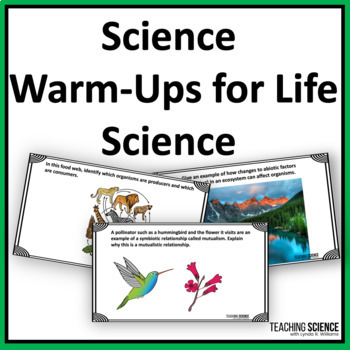Science Bell Ringers & Science Warm Ups for Life Science Middle School No Prep
- Zip
What educators are saying
Also included in
- This NGSS Middle School Science Bundle is my biggest bundle! It includes all my middle school science units, Bell Ringers, Jeopardy-style games, Assessments, and Informational Text Science Units for Middle School. It addresses all the NGSS standards for 6th, 7th, and 8th Grade NGSS science. Save whePrice $489.55Original Price $699.35Save $209.80
- Do you teach life science in middle school? Perfect for 6th, 7th, and 8th Grade life science. Purchase this life science bundle and save 20%. This bundle covers all the life science standards for middle school NGSS. LS1: From Molecules to Organisms: Structures and Processes, LS2: Interactions, EnerPrice $122.88Original Price $153.60Save $30.72
- Are you looking for no-prep, no-grading science bell ringers? These science bellringers and warm-ups are great for engaging students in science concepts as soon as they walk through the door. These bell ringers can be used to review science concepts quickly and as conversation starters. This bundlePrice $25.00Original Price $31.25Save $6.25
Description
Do you want a no-prep, no-grading way to review life science concepts with your students? These science bell ringers are great for engaging students in science concepts as soon as they walk through the door. Science Warm Ups and Bell Ringers can be used to review science concepts quickly and as conversation starters. There are 50 life science warm-ups in the slide show presentation. Answer sheets for student responses are in a variety of formats. Answer keys for each warm-up are included. This set focuses on life science concepts from the middle school science standards.
Why do you need these?
- No-prep materials
- No-grading needed
- Helps students review and retain information
Resource Includes:
- 50 slides, each with a Life Science question to answer (PPT format)
- Open-ended and short answer questions
- 12 different answer sheet formats (weekly, quarter sheet, half sheet, science notebook, etc.)
- Answer Keys for each slide
- No-Prep-No Grading Option
Teachers Love these life science bell ringers !❤️❤️❤️
Aimie ⭐️ ⭐️ ⭐️ ⭐️ ⭐️ Extremely Satisfied
These warm-ups are so beautiful and colorful! My students always enjoy them - I have the earth science warm-ups, as well, and use them often.
Students will love these engaging life science slides that help them to review previously learned information.
Lauren ⭐️ ⭐️ ⭐️ ⭐️ ⭐️ Extremely Satisfied
My students like coming into class daily to see which prompt would be on the board. Very easy to use, and happy it came with an answer key. One less thing to prep!
Great for independent work. These warm-ups are a great way to start class each day.
Topics Addressed:
- Ecosystems and Food Webs
- Human Systems
- Evolution and Natural Selection
- Genetics and Traits
- Adaptations
- Habitat
- Cells
- Photosynthesis
- Selective Breeding
- Abiotic and biotic
- Competition and predation
- Resource availability
- Symbiosis
- Trophic levels
- Asexual reproduction
- Chemical and Physical Digestion
Follow me and get news of my new resources. Each new resource is discounted by 50% for the first 24 hours!
You will love my other life science materials for Middle School:
Sensory Receptors and the Nervous System
Chemical Digestion and Cellular Respiration
My resources are not editable for copyright reasons.








